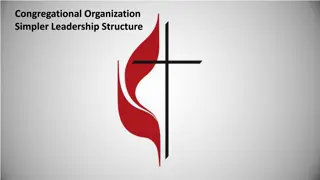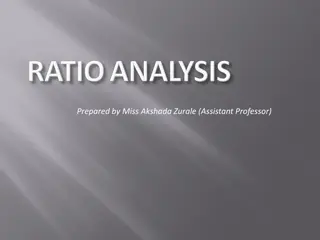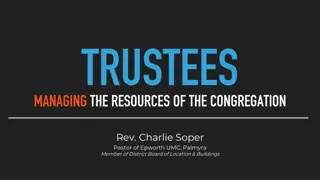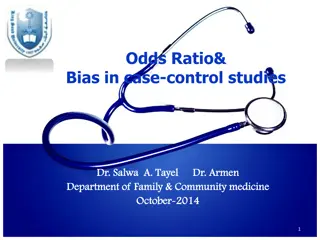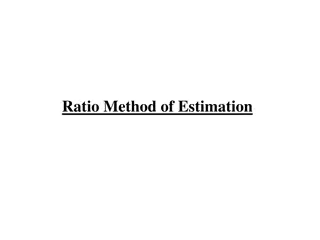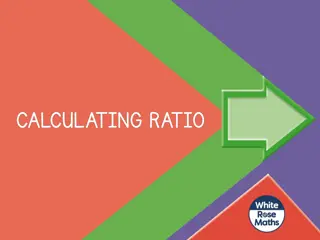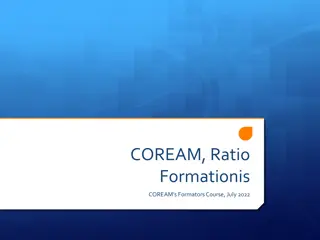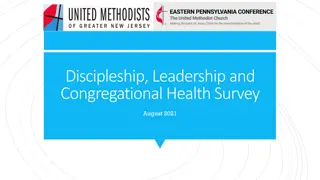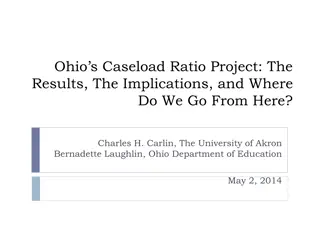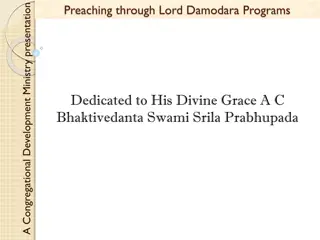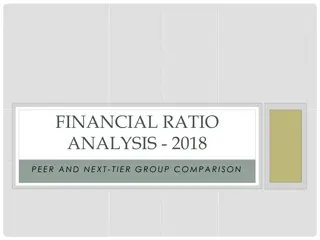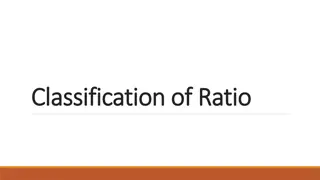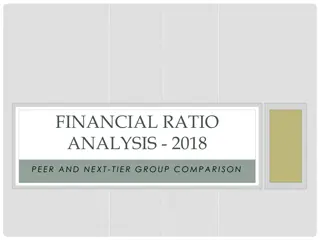Evolution of the Ratio Formationis Generalis in Congregational Formation
Evolution and significance of the Ratio Formationis Generalis in Congregational Formation, from its historical development to the need for updates in response to changes in formation programs and Vatican documents. The formation of Units, Conferences, Directories, and Programs based on the Ratio, highlighting the importance of aligning with its values and principles for effective formation. The 12-year journey to develop the 2003 Ratio Formationis Generalis marked a pivotal moment in providing continuity and cohesion to the Congregation's formation processes. The call for an updated version post-2016 and its implications for the Congregation's restructuring and reconfiguration.
Download Presentation

Please find below an Image/Link to download the presentation.
The content on the website is provided AS IS for your information and personal use only. It may not be sold, licensed, or shared on other websites without obtaining consent from the author. Download presentation by click this link. If you encounter any issues during the download, it is possible that the publisher has removed the file from their server.
E N D
Presentation Transcript
RATIO FORMATIONIS GENERALIS (Actualized in 2020)
What is a Ratio Formationis?
Values and principles that should be the foundation for formation.
From the Ratio Formationis Generalis, the particular Ratio (Congregation s Units and Conferences) are formulated. Directories Also formulated from the Ratio are: - the Directories, which correspond to the structures adopted by the Units and Conferences for formation, and Programs - the Programs, which are the actual day by day, concrete proposals for formation and the living out of the values and principles of the Ratio Formationis Generalis.
A brief history of the Ratio Formationis Generalis: Before 1991 the Congregation had four Ratio: Brothers, Novitiate, Clerics and Continuing Formation. The 1991 General Chapter mandated the elaboration of a single Ratio Formationis Generalis to give more continuity and cohesi n to formation. It was not until 12 years later that the 2003 Ratio Formationis Generalis was completed and approved by the General Government.
The 25th General Chapter in 2016 asked that an evaluation of the formation programs in the Congregation be done by each Unit and Conference. The General Secretariat of Formation, reflecting on this decisi n, saw that any evaluation of the formation programs would need a reference point, which logically is the Ratio Formationis Generalis, but it needed to be updated.
Why an update of the Ratio Formationis Generalis? Since 2003: - the Congregation had celebrated two General Chapters, both of which made references to formation - In 2015 the General Government had published the Decree on Formation which established a vocabulary and essential elements with regards to each of the different stages of formaton, and thirdly, - The Vatican had published several very important documents related to formation and Consecrated Life, including the results of different Synods of Bishops. The need for an actualized Ratio was also seen from the perspective of Restructuring and Reconfiguration.
Both Restructuring and Reconfiguration take their motivation and are energized from fidelity to the Redemptorist Mission and Charism. While it is generally agreed that the term Restructuring is not the best, it is functional within our understanding of the inclusion of concepts like conversion and faithfulness to our Charism. The concept and values of restructuring appear in our Constitutions, for example, Constitution # 96 when speaking of adaptations to apostolic necessities.
Reconfiguration has more to do with the structures (size, geographic areas, etc.) of our Units. As with restructuring, renewed configuration is also reflected in our Constitutions and Statues (cf. Const. # 96 and Statutes #s 087 090). The reconfiguration of Units leads to the consequent reconfiguration of Directories and Formation programs.
The profile of the Redemptorist Confrere shaped by the new vision of restructuring (cfr. Final Documents of the 24th General Chapter, 6.12 to 6.17). 6.12 The principles of restructuring assure the continuity of our fundamental identity and mission as Redemptorists in our Church and in the world. At the same time, they call for new realities and structures that would give fresh impetus to that mission and identity. 6.13 This is a possible profile of a confrere in a re-structured Congregation.
6.14 This confrere would participate in a Novitiate program of various Units, usually belonging to the same Conference. He would interact with confreres from other countries, cultures, and maybe even languages. Comment: In general, this is going well within the whole Congregation. However, some exceptions have had to be made because of special circumstances, including the restrictions on travel and the obtaining of visas to some countries. What we have seen is that the common Conference novitiates create long-lasting relationships and bonds between confreres from different Units. Where there is common preparation for Perpetual Vows programs in the Conferences, these relationships and bonds are strengthened with the coming together again of the confrere candidates. These strong relationships influence and benefit the overall Mission of the Congregation.
6.15 During his initial formation the Redemptorist confrere would learn about the Charism of the Congregation and the special gifts and apostolates of his own Unit. He would understand from our history that constant renewal and restructuring have been vital for the continuity and continuation of our mission. 6.16 When the confrere makes his vows, his commitment will be to the whole Congregation and not simply to a particular Unit. This commitment will be given practical expression in the Unit and the Conference to which he belongs. He will need to have a wider grasp of the changing circumstances, human realities and apostolic priorities not only of his Unit but of the entire Conference to which his Unit belongs. He will, for example, have to learn about the phenomenon of migrants within the geographic area of the Conference. He will, to give another example, be able to participate in the ministry of Redemptorist shrines within his Conference, a ministry growing in importance within the modern phenomenon of popular religious devotion.
6.17 Above all, the Redemptorist confrere will know that he belongs to and willingly participates in the mission of the world-wide Congregation that takes seriously the challenge of being alert to the signs of the times and the making of vital apostolic decisions that respond ever anew to our call to mission.
Some questions for our reflection: 1. In light of the evaluation of the formation programs asked for by the 25th General Chapter, do you think that a justified starting point is the Updated Ratio FormationisGeneralis of 2020, that is, the document that presents guidelines, principles and values that regulate formation? Please explain?
2.Concretely, how have Restructuring and Reconfiguration influenced formation in your Conference? 3. What should we as a Congregation do to continue to strengthen our formation programs for the sake of truly preparing future Redemptorist for the mission of the Congregation as presented in the priorities of the Conference (Decision, # 30, 25th General Chapter).
Recources and References: Formation webpage: www.cssr.news/formation/ (1. 2020 Ratio Formationis Generalis)




